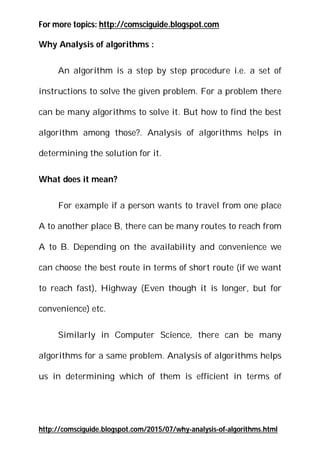
How analysis of algorithms is done?
- 1. Also See more posts : www.comsciguide.blogspot.com Also See more posts : www.comsciguide.blogspot.com Why Analysis of algorithms : An algorithm is a step by step procedure i.e. a set of instructions to solve the given problem. For a problem there can be many algorithms to solve it. But how to find the best algorithm among those?. Analysis of algorithms helps in determining the solution for it. What does it mean? For example if a person wants to travel from one place A to another place B, there can be many routes to reach from A to B. Depending on the availability and convenience we can choose the best route in terms of short route (if we want to reach fast), Highway (Even though it is longer, but for convenience) etc. Similarly in Computer Science, there can be many algorithms for a same problem. Analysis of algorithms helps us in determining which of them is efficient in terms of space (memory) and running time by comparing the algorithms. But how to compare algorithms ?
- 2. Also See more posts : www.comsciguide.blogspot.com Also See more posts : www.comsciguide.blogspot.com How to compare algorithms ? Running time is best measure for comparing the algorithms. It is the process of determining the processing time increases as the size of input size (problem) increases. Input size may vary depending on the type of problems. In general we encounter the following types of inputs. 1) Size of array 2) No of elements in the matrix 3) Polynomial degree 4) Vertices and edges in a graph In general, the running time of a algorithm is expressed as a function of input size(n) i.e. f(n) and compare these functions corresponding with their running times. This is independent of machine time, processor, programme style (no of statements) etc. Types of analysis : To analyse the algorithm, we need to represent the algorithm with multiple expressions: one for the case where it takes less time
- 3. Also See more posts : www.comsciguide.blogspot.com Also See more posts : www.comsciguide.blogspot.com and the other for the case where it takes more time. The first case is called as Best case and the second case is called as Worst case for that algorithm. There are three types of analysis: 1) Best case 2) Average case 3) Worst case For a given algorithm, we can represent the best, worst, average cases in the form of expressions. For example Let f(n) be the function represents the given algorithm and n is the input size, f(n) = n2 + n + 100 ; for worst case f(n) = 5n + 200 ; for best case The expressions defines the input for which the algorithm takes the less or average time (or memory). If both best and worst
- 4. Also See more posts : www.comsciguide.blogspot.com Also See more posts : www.comsciguide.blogspot.com cases, points to one expression then that expression can be represented with average case. f(n) = 10n + 50 ; for best and worst case then f(n) can be represented for average case. f(n) = 10n + 50 ; for average case
